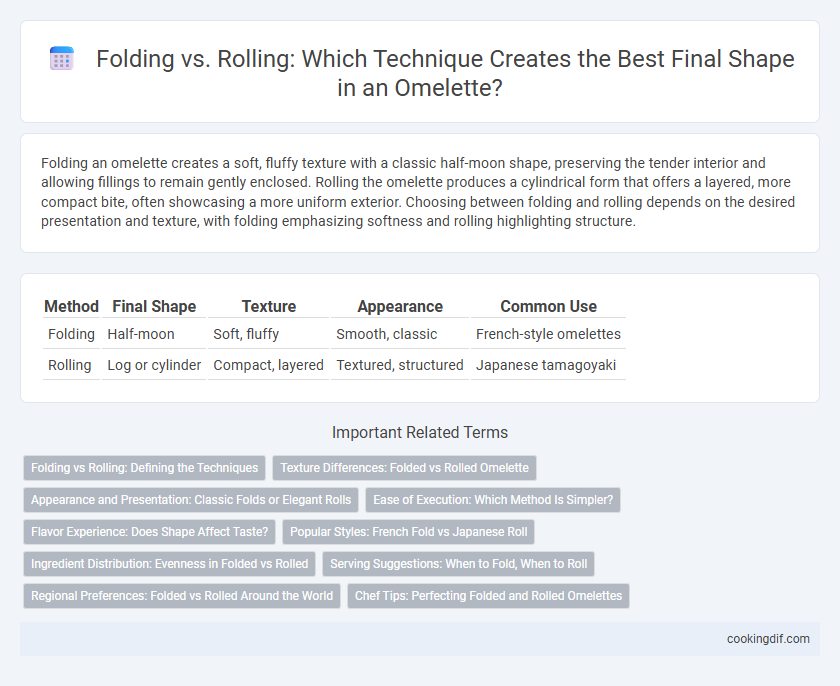Folding an omelette creates a soft, fluffy texture with a classic half-moon shape, preserving the tender interior and allowing fillings to remain gently enclosed. Rolling the omelette produces a cylindrical form that offers a layered, more compact bite, often showcasing a more uniform exterior. Choosing between folding and rolling depends on the desired presentation and texture, with folding emphasizing softness and rolling highlighting structure.
Table of Comparison
| Method | Final Shape | Texture | Appearance | Common Use |
|---|---|---|---|---|
| Folding | Half-moon | Soft, fluffy | Smooth, classic | French-style omelettes |
| Rolling | Log or cylinder | Compact, layered | Textured, structured | Japanese tamagoyaki |
Folding vs Rolling: Defining the Techniques
Folding an omelette involves gently bending it over itself to create a soft, layered shape that retains a tender texture and allows fillings to be visible inside. Rolling an omelette requires carefully rolling the egg mixture into a cylindrical shape, offering a uniform consistency and often a firmer exterior, popular in Japanese tamagoyaki preparation. Both techniques impact the omelette's final presentation and texture, with folding emphasizing a delicate, airy finish and rolling yielding a compact, structured form.
Texture Differences: Folded vs Rolled Omelette
Folding an omelette creates a soft, slightly airy texture with tender layers that retain moisture, resulting in a delicate mouthfeel. Rolling an omelette compresses the egg mixture into a denser, more uniform texture, often producing a firmer and chewier bite. The choice between folding and rolling significantly influences the final omelette's textural contrast and overall eating experience.
Appearance and Presentation: Classic Folds or Elegant Rolls
Folding an omelette creates a classic, semi-circular shape that showcases a fluffy, layered texture ideal for traditional breakfast presentations. Rolling produces a sleek, cylindrical form with smooth edges, offering a refined and elegant appearance often favored in upscale dining. Both techniques emphasize different visual aesthetics, with folds highlighting volume and rolls emphasizing polish and sophistication.
Ease of Execution: Which Method Is Simpler?
Folding an omelette typically offers greater ease of execution due to its straightforward technique, requiring only a gentle lift and fold when the eggs are partially set, minimizing the risk of tearing. Rolling demands more precision and timing, as it involves carefully rolling the omelette while it is still soft and slightly undercooked, making it less forgiving for beginners. Hence, folding is generally considered simpler and more accessible for cooks of all skill levels seeking a perfect final shape.
Flavor Experience: Does Shape Affect Taste?
Folding an omelette creates layered textures that enhance the interplay of flavors by trapping steam and moisture, resulting in a tender bite with concentrated tastes. Rolling integrates fillings smoothly, offering a uniform flavor profile and a slightly denser texture that can intensify the richness of ingredients like cheese or herbs. The choice between folding and rolling subtly influences the flavor experience by altering moisture distribution and texture, ultimately shaping how taste is perceived in each bite.
Popular Styles: French Fold vs Japanese Roll
The French fold omelette features a tender, creamy interior with a smooth exterior, achieved by gently folding the cooked eggs into thirds to create a classic half-moon shape. The Japanese roll omelette, or tamagoyaki, is made by layering thin sheets of egg and rolling them tightly to form a cylindrical log, resulting in a slightly sweet, spongy texture. Both styles emphasize delicate techniques that enhance flavor and presentation but differ in texture and final appearance due to their unique folding and rolling methods.
Ingredient Distribution: Evenness in Folded vs Rolled
Folding an omelette creates distinct layers that trap ingredients between the eggs, leading to a more even distribution of fillings like cheese, vegetables, and meats. Rolling an omelette results in a spiral shape where ingredients tend to concentrate in the center, causing uneven ingredient spread and a more intense flavor core. For balanced ingredient distribution throughout every bite, the folded omelette is preferable over the rolled technique.
Serving Suggestions: When to Fold, When to Roll
Folding an omelette creates a classic, tender texture ideal for delicate fillings like cheese, herbs, and mushrooms, making it perfect for elegant breakfast presentations or light meals. Rolling an omelette provides a compact, layered shape that holds heartier fillings such as vegetables, meats, or seafood, suitable for grab-and-go lunches or more substantial servings. Choose folding for a refined, soft finish, while rolling suits robust ingredients and convenient, portable portions.
Regional Preferences: Folded vs Rolled Around the World
Folded omelettes dominate Western culinary traditions, offering a classic half-moon shape favored in French and American breakfasts for its simplicity and visual appeal. Rolled omelettes, such as the Japanese tamagoyaki, showcase a delicate, layered texture achieved by repeatedly rolling thin layers of egg, reflecting East Asian preferences for refinement and precision. These regional variations highlight cultural tastes, with folded versions emphasizing a rustic ease and rolled styles valuing meticulous craftsmanship.
Chef Tips: Perfecting Folded and Rolled Omelettes
Mastering the final shape of an omelette hinges on precise folding and rolling techniques that enhance texture and appearance. Folding creates a fluffy, layered interior by gently lifting and folding the cooked egg, while rolling forms a sleek, cylindrical shape by continuously tucking and turning the omelette in the pan. Chefs recommend using medium-low heat and a non-stick skillet to prevent tearing, applying light pressure with a spatula for folding, and ensuring the eggs are slightly undercooked before rolling for a tender, moist finish.
Folding vs Rolling for final shape Infographic

 cookingdif.com
cookingdif.com